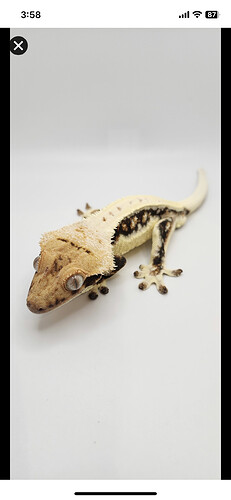Hey everyone. I am potentially going to buy a gecko that is listed as possible Capp and was wondering if I could get some help determining it. I have attached the baby, mother and father. Thank you
I think it looks promising, however unfortunately capp is pretty much impossible to confirm just by looking at a photo, since other phenotypes look pretty much the same, and some capp combos look like other non-capp combos. Determining if something is a capp has a lot to do with how it progresses as well. If the seller listed it as a possible from a proven capp, it’s likely because it doesn’t look quite like the other capps they’ve hatched, but still has some markers ![]()
If you dedice to get it, you’d want to breed it to a lilly white to get a more solid answer. Super capps aren’t viable so make sure to avoid other potential/proven capps😊
I don’t see Cap myself but unless proven out you never know these days.
Looks like a Harley partial pin Dalmatian hiding by pic though. X
Also going to assume that dad’s been ‘proven’ as a cap?
Yes the dad has been “Proven” to be a Capp. My understanding is that would make any of his kids Capps right?
No each kid would have 50/50 chance of being capp - what is known as a capp is the het version of the trait with super capps being the homozygous version ![]()
I agree that it doesn’t look too be a cap, but could be het. I also agree, since the dads proven, babies will have 50 50 chance to be cap. But your need to breed to prove
I thought capp didn’t have hets? How could it be het capp?
A trait can either be heterozygous or homozygous, so all traits have hets - what we know as a capp is the het version, so it’s a bit redundant to say het cap, but not technically wrong ![]() Empty Back, Dalmatian and Whitewall/Whiteout are all visual but people will still sometimes say for example het EB to emphasize that it isn’t the full version
Empty Back, Dalmatian and Whitewall/Whiteout are all visual but people will still sometimes say for example het EB to emphasize that it isn’t the full version
Yeah I guess I shouldn’t of used the term het… But that’s how my brain processes it lol
I get that, honestly i think it’s much easier to grasp if you think of all the traits as hets and hzgs - makes it easier to predict the potential outcome of a breeding if you know that het means 50/50 and hzg means 100% for example; ofc that’s a bit of an oversimplification, but still, i think it helps
Yeah i get it, its just confusing that it works like that. Like some combos hets don’t do anything, but like with Capp, a super capp is a melanistic (I think.)
It was thought to be at first but as they grew they realised that it isn’t really a melanistic so it’s just called a super capp nowadays - het just means that it has one copy of the gene nothing more; if the gene is a simple dominant het and hzg will look the same (like yellow base or pinstriping), if it’s an incomplete dominant het and hzg will be different (like capp, LW and whiteout/whitewall, hzg form is also known as the super form or complete form), and if it’s recessive then het won’t be visible only hzg will ![]()


